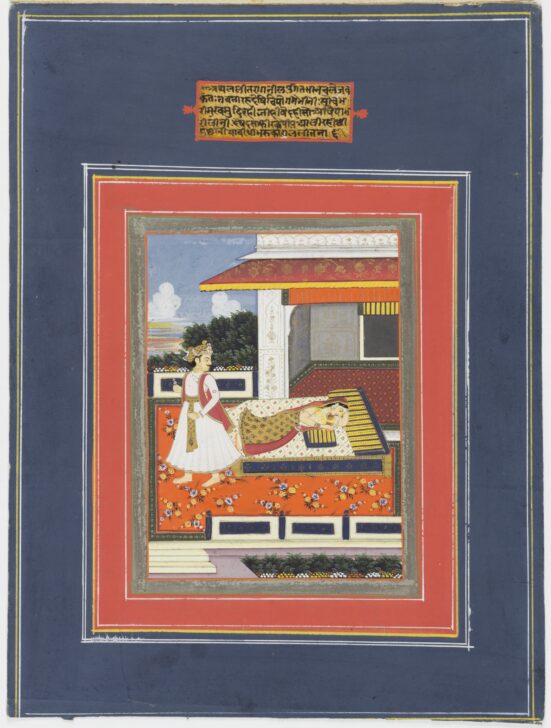Ragamala: Lalit Ragini
Artist Unknown, India, Rajasthan, Jaipur School

Description
Subject Matter:
Ragamala paintings draw from aspects of human experience in order to visualize specific moods, emotions, and qualities such as love, anguish, valor, weakness, and strength. A raga in Indian music is a melody consisting of a string of notes in a particular arrangement. Raginis are derivations from or variations of ragas in feminine mode (the basis of these classifications remains unexplained in many cases), and could have different or similar musical structures as ragas. Specific ragas are associated with specific times of the day, seasons, and emotions. When visualized, as here, ragas and raginis are meant to evoke the same affective responses that are allied to their musical modes. The text above the illustration refers to stories or incidents associated with the depicted raga/ ragini, but may not necessarily be narrative-like or descriptive. Drawn from literary tropes and tales that sophisticated writers and viewers would be aware of, the inscriptions are an integral part of the overall experience of this miniature painting. An illiterate viewer, however, could still enjoy the scene without reading the text.
Here, a woman lies down on the bed, while her lover is shown departing during daytime. After a night of lovemaking, the beloved feigns anger and swoons so that her lover will stay a little while longer. She coyly hides her face, and her shyness, comparable to a musical composition that does not reveal itself all at once, adds to her appeal. In some versions of this raga painting, a maidservant is present who informs the lover of his mistress's state of mind. Ragmala paintings also find place within the Pahari and Deccani painting traditions of the Indian subcontinent.
Physical Description:
A standing male figure on the left looks back towards a female figure lying down on a bed. They are on an open terrace, and a pavilion/ building is shown in the background. It is day time and the sky is cloudy. A verse appears above the scene. The colors are bright.
Usage Rights:
If you are interested in using an image for a publication, please visit https://umma.umich.edu/request-image/ for more information and to fill out the online Image Rights and Reproductions Request Form.